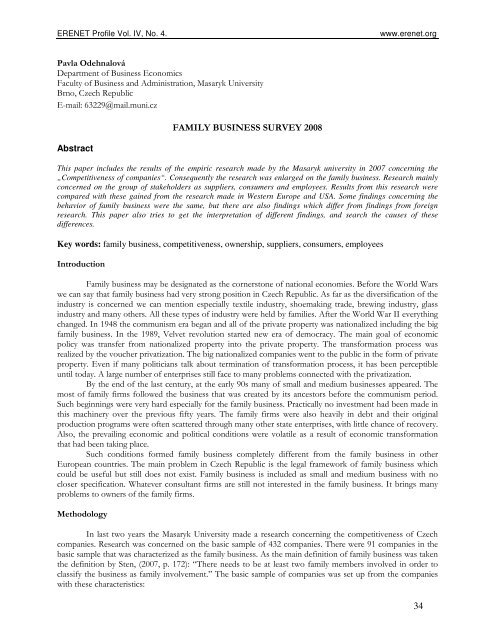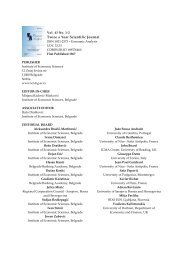Issue 16
Issue 16
Issue 16
Create successful ePaper yourself
Turn your PDF publications into a flip-book with our unique Google optimized e-Paper software.
ERENET Profile Vol. IV, No. 4.<br />
www.erenet.org<br />
Pavla Odehnalová<br />
Department of Business Economics<br />
Faculty of Business and Administration, Masaryk University<br />
Brno, Czech Republic<br />
E-mail: 63229@mail.muni.cz<br />
Abstract<br />
FAMILY BUSINESS SURVEY 2008<br />
This paper includes the results of the empiric research made by the Masaryk university in 2007 concerning the<br />
„Competitiveness of companies“. Consequently the research was enlarged on the family business. Research mainly<br />
concerned on the group of stakeholders as suppliers, consumers and employees. Results from this research were<br />
compared with these gained from the research made in Western Europe and USA. Some findings concerning the<br />
behavior of family business were the same, but there are also findings which differ from findings from foreign<br />
research. This paper also tries to get the interpretation of different findings, and search the causes of these<br />
differences.<br />
Key words: family business, competitiveness, ownership, suppliers, consumers, employees<br />
Introduction<br />
Family business may be designated as the cornerstone of national economies. Before the World Wars<br />
we can say that family business had very strong position in Czech Republic. As far as the diversification of the<br />
industry is concerned we can mention especially textile industry, shoemaking trade, brewing industry, glass<br />
industry and many others. All these types of industry were held by families. After the World War II everything<br />
changed. In 1948 the communism era began and all of the private property was nationalized including the big<br />
family business. In the 1989, Velvet revolution started new era of democracy. The main goal of economic<br />
policy was transfer from nationalized property into the private property. The transformation process was<br />
realized by the voucher privatization. The big nationalized companies went to the public in the form of private<br />
property. Even if many politicians talk about termination of transformation process, it has been perceptible<br />
until today. A large number of enterprises still face to many problems connected with the privatization.<br />
By the end of the last century, at the early 90s many of small and medium businesses appeared. The<br />
most of family firms followed the business that was created by its ancestors before the communism period.<br />
Such beginnings were very hard especially for the family business. Practically no investment had been made in<br />
this machinery over the previous fifty years. The family firms were also heavily in debt and their original<br />
production programs were often scattered through many other state enterprises, with little chance of recovery.<br />
Also, the prevailing economic and political conditions were volatile as a result of economic transformation<br />
that had been taking place.<br />
Such conditions formed family business completely different from the family business in other<br />
European countries. The main problem in Czech Republic is the legal framework of family business which<br />
could be useful but still does not exist. Family business is included as small and medium business with no<br />
closer specification. Whatever consultant firms are still not interested in the family business. It brings many<br />
problems to owners of the family firms.<br />
Methodology<br />
In last two years the Masaryk University made a research concerning the competitiveness of Czech<br />
companies. Research was concerned on the basic sample of 432 companies. There were 91 companies in the<br />
basic sample that was characterized as the family business. As the main definition of family business was taken<br />
the definition by Sten, (2007, p. 172): “There needs to be at least two family members involved in order to<br />
classify the business as family involvement.” The basic sample of companies was set up from the companies<br />
with these characteristics:<br />
34
















